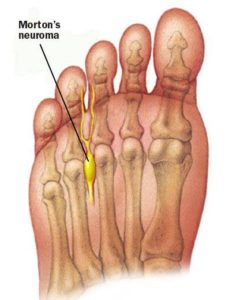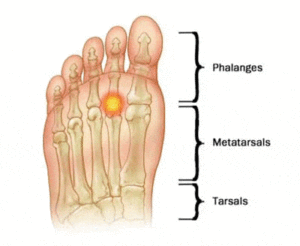You have been suffering from ball of foot pain for the past few months, which has resulted in a sudden reduction in your physical activity. You have found that when weight-bearing you experience a greater amount of pain compared to periods of rest. Metatarsalgia is a condition which affects the ball of your feet resulting in pain and inflammation.
To determine the exact cause of the pain you are experiencing, medical imaging is required to provide a diagnosis. The three main conditions that will fall under the bracket of Metatarsalgia include conditions such as Morton’s Neuroma, Inter-digital Bursitis and Sesamoiditis.
Morton’s Neuroma
A Morton’s neuroma is typically characterized by pain experienced within the 3rd and 4th web-spaces, in which you may feel like you are standing on pebbles. Quite often there is a thickening of the tissues that surround the nerves, resulting in pain. The symptoms that are associated with a Morton’s neuroma will include a sharp, burning sensation which can result in the toes feeling numb. More often than not those who develop a neuroma will do some from irritation, injury or pressure to the nerves.

Risk factors that are associated with neuromas and some bursitis include:
– wearing high heels
– Ill- fitting shoes
– high impact sports such as running
– repetitive trauma
– foot deformities such as bunions, hammer toes, high arches and flat feet
Inter-digital Bursitis
A bursitis occurs due to inflammation of the bursa, which contains small fluid filled sacs. They typically occur between two structures such as muscles, tendons and bones. You may experience pain and a restriction in movements as Bursitis can cause pain and restrict movements due to inflammation. Quite often shoulders, hip, knee and heel are the most common locations.

It has been found that those who develop bursitis may experience one or more of the following symptoms:
– localized pain
– swelling
– warm temperature
– increased pain at night
– pain worse during movements
– stiffness
– redness of the skin
Sesamoiditis
Located at the bottom of your 1st big toe joint are two small bones about the size of peas which are connected to the flexor tendons. The sesamoids function as a pulley to allow movement within the big toe joint. Pain is often experienced at this location due to injury from activities such as Ballet, catchers in baseball/ softball or running. In some cases the tendons surrounding the bones will become inflamed or the sesamoid bones may be fractured.

When a fracture occurs typically swelling and pain experienced will occur behind the big toe with a sudden onset.
Risk factors that are associated with sesamoiditis may include:
– High impact sports
– High heel shoes
– Foot deformities and poor foot biomechanics
– Inflammatory arthritis
If you have been experiencing any of these symptoms, come in today for an assessment with one of our podiatrists. They will tailor a treatment plan for recovery and pain management. Call us on 03 8645 9800 or
Image reference:
https://www.myfootdr.com.au/conditions-treated/sesamoiditis/

